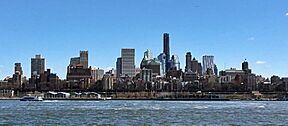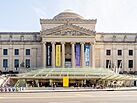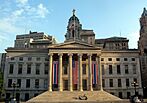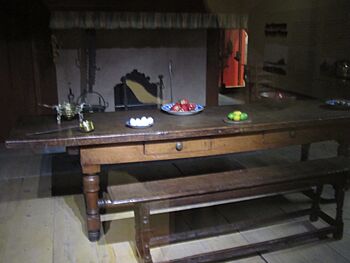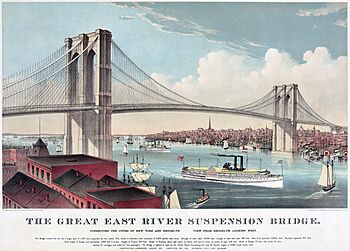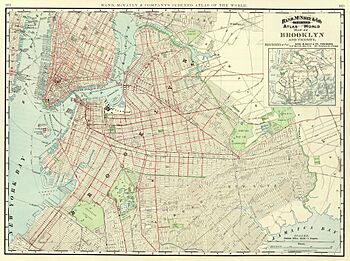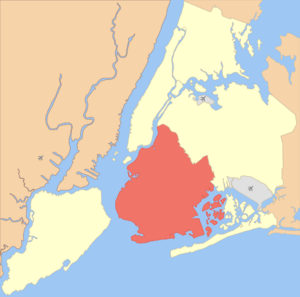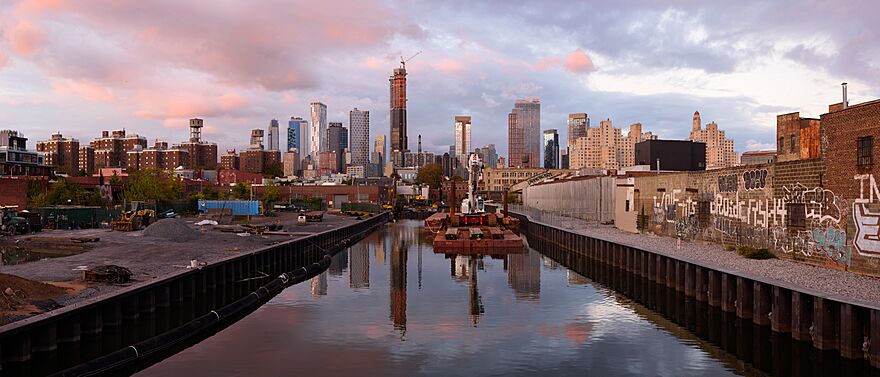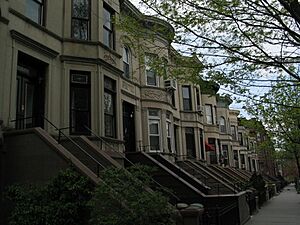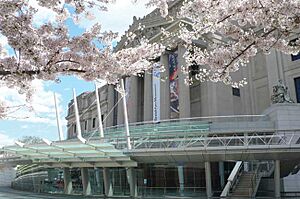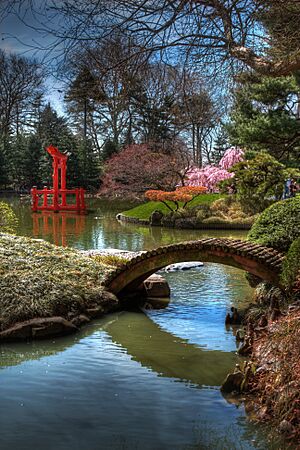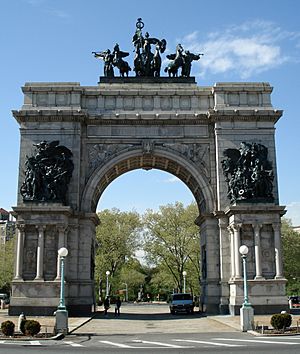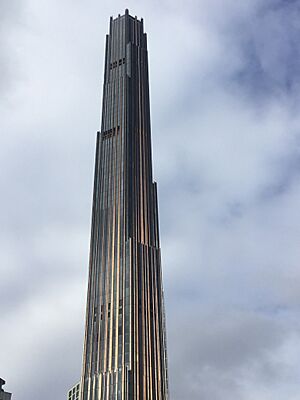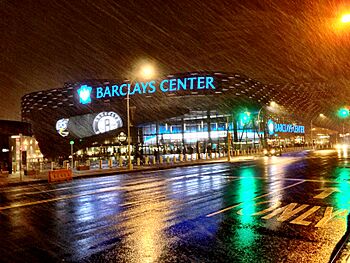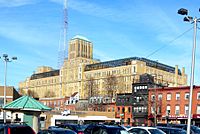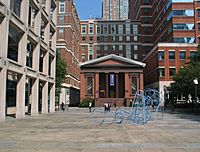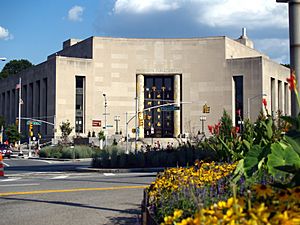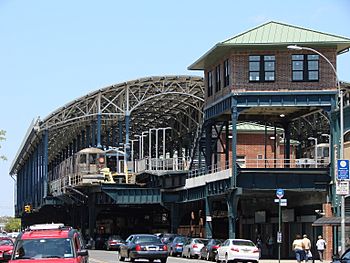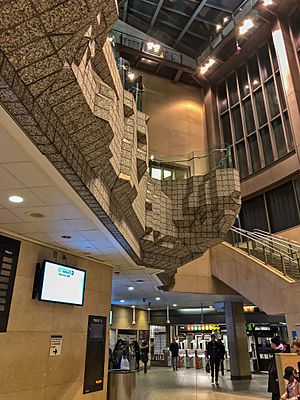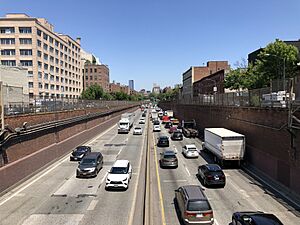Brooklyn facts for kids
Quick facts for kids
Brooklyn
Kings County, New York
|
|||
|---|---|---|---|
|
Downtown Brooklyn seen from Lower Manhattan
|
|||
|
|||
| Motto(s):
Eendraght Maeckt Maght
("Unity makes strength") |
|||
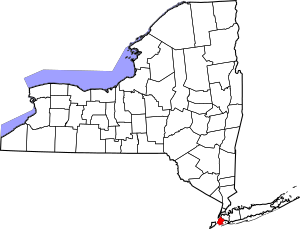
Brooklyn in New York State
|
|||
| Country | |||
| State | New York | ||
| County | Kings (coterminous) | ||
| City | New York City | ||
| Settled | 1634 | ||
| Named for | Breukelen, Netherlands | ||
| Government | |||
| • Type | Borough | ||
| Area | |||
| • Total | 97 sq mi (250 km2) | ||
| • Land | 70.82 sq mi (183.4 km2) | ||
| • Water | 26 sq mi (67 km2) | ||
| Highest elevation | 220 ft (67 m) | ||
| Population
(2020)
|
|||
| • Total | 2,736,074 | ||
| • Density | 38,634/sq mi (14,917/km2) | ||
| • Demonym | Brooklynite | ||
| GDP | |||
| • Total | US$107.274 billion (2022) | ||
| ZIP Code prefix |
112
|
||
| Area codes | 718/347/929, 917 | ||
| Congressional districts | 7th, 8th, 9th, 10th, 11th | ||
Brooklyn is a huge part of New York City, located at the western end of Long Island. It used to be its own city! Today, it's also known as Kings County, one of the first counties set up in New York way back in 1683.
As of 2020, over 2.7 million people live in Brooklyn. This makes it the most populated of New York City's five boroughs. It's also the most crowded county in New York State, after Manhattan. If Brooklyn were still an independent city, it would be the fourth largest city in the United States!
Brooklyn got its name from a Dutch town called Breukelen in the Netherlands. It shares a land border with Queens. You can get to Manhattan from Brooklyn using famous bridges like the Brooklyn Bridge and tunnels. The Verrazzano-Narrows Bridge connects Brooklyn to Staten Island.
The Dutch first settled Brooklyn in the 1600s. By the 1800s, it had become a busy port city. In 1898, Brooklyn joined with other areas to form the New York City we know today. Even though it's part of a bigger city, Brooklyn still has its own unique culture. Many neighborhoods are home to different groups of people from all over the world. Its official motto, "Eendraght Maeckt Maght," means 'Unity makes strength' in old Dutch.
Brooklyn is home to famous places like Brooklyn College and the Barclays Center, where the Brooklyn Nets basketball team plays. In recent years, Brooklyn has become a popular place for artists and new businesses.
Contents
- What's in a Name? The Story of Brooklyn's Name
- Brooklyn's Past: A Look at Its History
- Brooklyn's Location: Geography
- Brooklyn's Many Communities: Neighborhoods
- A Mix of Cultures: Community Diversity
- Jewish American Communities
- Chinese American Communities
- Caribbean and African American Communities
- Hispanic American Communities
- Russian and Ukrainian American Communities
- Polish American Communities
- Italian American Communities
- Arab American & Muslim Communities
- Irish American Communities
- South Asian American Communities
- Greek American Communities
- LGBTQ Community
- Artists in Brooklyn
- A Mix of Cultures: Community Diversity
- Brooklyn's People: Demographics
- Brooklyn's Vibe: Culture
- Brooklyn's Work: Economy
- Fun Places: Parks and Attractions
- Where People Live: Housing
- Learning in Brooklyn: Education
- Brooklyn Public Library
- Getting Around: Transportation
- Brooklyn's Global Friends: Partnerships with Other Cities
- Staying Healthy: Hospitals and Healthcare
- See also
What's in a Name? The Story of Brooklyn's Name
The name Brooklyn comes from the Dutch town of Breukelen. The oldest record of this Dutch town dates back to 953 AD. Its name means "bog" or "marshland" and "small water stream."
When the Dutch settled in America in 1646, they named their new settlement "Breuckelen." Over time, the name changed its spelling many times. Some thought it meant "broken land." But the current name, Brooklyn, best shows its original meaning from the Dutch word.
Brooklyn's Past: A Look at Its History
The story of European settlement in Brooklyn goes back over 350 years. It started as a small Dutch town called "Breuckelen" in the 1600s. By the 1800s, it had grown into a large city. In 1898, Brooklyn joined with other areas to form the modern New York City.
Early Days: The Colonial Era
Dutch Beginnings in New Netherland
The Dutch were the first Europeans to settle on the western side of Long Island. This area was home to the Lenape Native American tribe. The Dutch named their settlement Breuckelen after a town in the Netherlands.
The Dutch West India Company quickly set up six original towns. These towns later became known by their English names:
- Gravesend: Settled in 1645 by English followers.
- Brooklyn Heights: Chartered as Breuckelen in 1646. This is where the village of Brooklyn was founded.
- Flatlands: Chartered as Nieuw Amersfoort in 1647.
- Flatbush: Chartered as Midwout in 1652.
- Nieuw Utrecht: Named after the city of Utrecht, Netherlands, in 1652.
- Bushwick: Chartered as Boswijck in 1661.
English Takeover: Province of New York
In 1664, the English took control of the Dutch colony, which they renamed New York. Brooklyn then became part of the Province of New York.
On November 1, 1683, Kings County was created. It included the six old Dutch towns on Long Island. This was the first time this area was recognized as a single political place.
Fighting for Freedom: The Revolutionary War
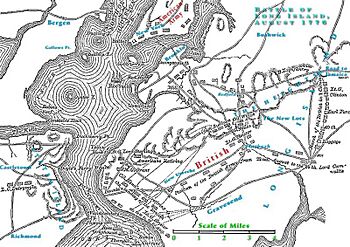
On August 27, 1776, the Battle of Long Island (also called the 'Battle of Brooklyn') took place. This was the first major battle of the American Revolutionary War after America declared its independence. It was also the largest battle of the entire war.
British troops pushed Continental Army soldiers, led by George Washington, off the hills near what are now Green-Wood Cemetery and Prospect Park. Washington had to move all his troops and supplies across the East River in one night. This clever move is now seen as one of his greatest successes.
The British controlled the area for the rest of the war. They set up prison ships off the coast of Brooklyn. More American patriots died on these ships than in all the battles of the war combined.
Growing Up: Post-Independence Era
Becoming a City: Urbanization
The early 1800s saw cities start to grow along the East River in Kings County, facing Manhattan. The New York Naval Shipyard was a major workplace during this time.
The Village of Brooklyn was officially created in 1816. Ferry service across the East River made Brooklyn Heights a popular place for people who worked in Wall Street. In 1834, the village and town combined to form the first City of Brooklyn.
The City of Williamsburgh (now Williamsburg) also grew quickly. In 1855, Williamsburgh and its surrounding area joined with the larger City of Brooklyn.
In 1841, The Brooklyn Eagle newspaper started. It helped create a separate identity for people living in Brooklyn. The famous Brooklyn Dodgers baseball team also helped with this. Sadly, both the newspaper and the baseball team left Brooklyn in the 1950s.
Brooklyn's population grew very fast. By 1830, there were over 15,000 people. A modern police force was created in 1855 with 150 officers.
Brooklyn's Role in the Civil War
Brooklyn played a big part in the American Civil War. The city sent many troops and supplies to help the Union. The most famous regiment was the 14th Brooklyn "Red Legged Devils." They wore red uniforms and were the only regiment named after a city.
As a port and manufacturing center, Brooklyn was good at building ships. The ironclad ship Monitor was built in Brooklyn.
The "Twin City" and Growth
Brooklyn was called the "twin city" of New York in a famous poem from 1883. This shows how important Brooklyn was back then.
Economic growth continued, with many new people moving in and industries growing. Brooklyn became the third most populated American city for much of the 1800s. Factories and piers were built along the waterfront.
The population kept growing. By the end of the 1800s, Brooklyn had taken over all the towns in Kings County, reaching its current size.
Mayors of the City of Brooklyn
Brooklyn had its own mayor from 1834 until 1898. After that, it became part of New York City. Now, Brooklyn has a Borough President instead of a mayor.
| Mayor | Start year | End year | ||
|---|---|---|---|---|
| George Hall | Democratic-Republican | 1834 | 1834 | |
| Jonathan Trotter | Democratic | 1835 | 1836 | |
| Jeremiah Johnson | Whig | 1837 | 1838 | |
| Cyrus P. Smith | Whig | 1839 | 1841 | |
| Henry C. Murphy | Democratic | 1842 | 1842 | |
| Joseph Sprague | Democratic | 1843 | 1844 | |
| Thomas G. Talmage | Democratic | 1845 | 1845 | |
| Francis B. Stryker | Whig | 1846 | 1848 | |
| Edward Copland | Whig | 1849 | 1849 | |
| Samuel Smith | Democratic | 1850 | 1850 | |
| Conklin Brush | Whig | 1851 | 1852 | |
| Edward A. Lambert | Democratic | 1853 | 1854 | |
| George Hall | Know Nothing | 1855 | 1856 | |
| Samuel S. Powell | Democratic | 1857 | 1860 | |
| Martin Kalbfleisch | Democratic | 1861 | 1863 | |
| Alfred M. Wood | Republican | 1864 | 1865 | |
| Samuel Booth | Republican | 1866 | 1867 | |
| Martin Kalbfleisch | Democratic | 1868 | 1871 | |
| Samuel S. Powell | Democratic | 1872 | 1873 | |
| John W. Hunter | Democratic | 1874 | 1875 | |
| Frederick A. Schroeder | Republican | 1876 | 1877 | |
| James Howell | Democratic | 1878 | 1881 | |
| Seth Low | Republican | 1882 | 1885 | |
| Daniel D. Whitney | Democratic | 1886 | 1887 | |
| Alfred C. Chapin | Democratic | 1888 | 1891 | |
| David A. Boody | Democratic | 1892 | 1893 | |
| Charles A. Schieren | Republican | 1894 | 1895 | |
| Frederick W. Wurster | Republican | 1896 | 1897 |
Joining New York City: The Borough Era
In 1883, the Brooklyn Bridge was finished. This made it much easier to travel to Manhattan.
People then debated if Brooklyn should join with other areas to form a bigger New York City. In 1894, residents of Brooklyn voted to merge. This happened in 1898. Kings County remained a New York State county, but Brooklyn lost its identity as a separate city. Many people at the time called this merger the "Great Mistake of 1898."
Brooklyn's Location: Geography
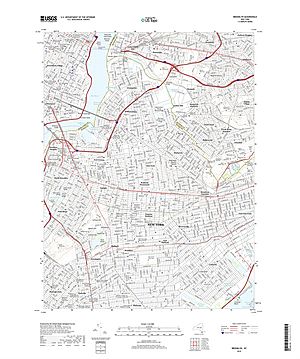
Brooklyn covers about 97 square miles. About 71 square miles are land, and 26 square miles are water. It's the second-largest borough in New York City by land area. Brooklyn is at the southwest end of Long Island.
Brooklyn has many water borders. These include Jamaica Bay, the Atlantic Ocean, and The Narrows, which separates Brooklyn from Staten Island. The East River separates Brooklyn from Manhattan. Many bridges and tunnels cross these waters. To the east, Brooklyn borders Queens.
Weather in Brooklyn: Climate
Brooklyn has a humid subtropical climate. This means it has warm, humid summers and mild winters. It gets a lot of rain all year, about 50 inches annually. Brooklyn also gets a good amount of sunshine, averaging 234 sunny days each year.
| Climate data for JFK Airport, New York (normals 1981–2010, extremes 1948–present) | |||||||||||||
|---|---|---|---|---|---|---|---|---|---|---|---|---|---|
| Month | Jan | Feb | Mar | Apr | May | Jun | Jul | Aug | Sep | Oct | Nov | Dec | Year |
| Record high °F (°C) | 71 (22) |
71 (22) |
85 (29) |
90 (32) |
99 (37) |
99 (37) |
104 (40) |
101 (38) |
98 (37) |
90 (32) |
77 (25) |
75 (24) |
104 (40) |
| Mean maximum °F (°C) | 56.8 (13.8) |
57.9 (14.4) |
68.5 (20.3) |
78.1 (25.6) |
84.9 (29.4) |
92.1 (33.4) |
94.5 (34.7) |
92.7 (33.7) |
87.4 (30.8) |
78.0 (25.6) |
69.1 (20.6) |
60.1 (15.6) |
96.6 (35.9) |
| Mean daily maximum °F (°C) | 39.1 (3.9) |
41.8 (5.4) |
49.0 (9.4) |
59.0 (15.0) |
68.5 (20.3) |
78.0 (25.6) |
83.2 (28.4) |
81.9 (27.7) |
75.3 (24.1) |
64.5 (18.1) |
54.3 (12.4) |
44.0 (6.7) |
61.6 (16.4) |
| Mean daily minimum °F (°C) | 26.3 (−3.2) |
28.1 (−2.2) |
34.2 (1.2) |
43.5 (6.4) |
52.8 (11.6) |
62.8 (17.1) |
68.5 (20.3) |
67.8 (19.9) |
60.8 (16.0) |
49.6 (9.8) |
40.7 (4.8) |
31.5 (−0.3) |
47.3 (8.5) |
| Mean minimum °F (°C) | 9.8 (−12.3) |
13.4 (−10.3) |
19.1 (−7.2) |
32.6 (0.3) |
42.6 (5.9) |
52.7 (11.5) |
60.7 (15.9) |
58.6 (14.8) |
49.2 (9.6) |
37.6 (3.1) |
27.4 (−2.6) |
16.3 (−8.7) |
7.5 (−13.6) |
| Record low °F (°C) | −2 (−19) |
−2 (−19) |
4 (−16) |
20 (−7) |
34 (1) |
45 (7) |
55 (13) |
46 (8) |
40 (4) |
30 (−1) |
19 (−7) |
2 (−17) |
−2 (−19) |
| Average precipitation inches (mm) | 3.16 (80) |
2.59 (66) |
3.78 (96) |
3.87 (98) |
3.94 (100) |
3.86 (98) |
4.08 (104) |
3.68 (93) |
3.50 (89) |
3.62 (92) |
3.30 (84) |
3.39 (86) |
42.77 (1,086) |
| Average snowfall inches (cm) | 6.3 (16) |
8.3 (21) |
3.5 (8.9) |
0.8 (2.0) |
0 (0) |
0 (0) |
0 (0) |
0 (0) |
0 (0) |
0 (0) |
0.2 (0.51) |
4.7 (12) |
23.8 (60) |
| Average precipitation days (≥ 0.01 inch) | 10.5 | 9.6 | 11.0 | 11.4 | 11.5 | 10.7 | 9.4 | 8.7 | 8.1 | 8.5 | 9.4 | 10.6 | 119.4 |
| Average snowy days (≥ 0.1 inch) | 4.6 | 3.4 | 2.3 | 0.3 | 0 | 0 | 0 | 0 | 0 | 0 | 0.2 | 2.8 | 13.6 |
| Average relative humidity (%) | 64.9 | 64.4 | 63.4 | 64.1 | 69.5 | 71.5 | 71.4 | 71.7 | 71.9 | 69.1 | 67.9 | 66.3 | 68.0 |
| Source: NOAA (relative humidity 1961–1990) | |||||||||||||
| Climate data for Brooklyn, New York City (Avenue V) | |||||||||||||
|---|---|---|---|---|---|---|---|---|---|---|---|---|---|
| Month | Jan | Feb | Mar | Apr | May | Jun | Jul | Aug | Sep | Oct | Nov | Dec | Year |
| Mean daily maximum °F (°C) | 39.7 (4.3) |
42.4 (5.8) |
49.7 (9.8) |
60.5 (15.8) |
70.5 (21.4) |
79.3 (26.3) |
84.8 (29.3) |
83.3 (28.5) |
76.5 (24.7) |
65.0 (18.3) |
54.3 (12.4) |
44.5 (6.9) |
62.5 (16.9) |
| Mean daily minimum °F (°C) | 27.5 (−2.5) |
29.1 (−1.6) |
35.2 (1.8) |
44.8 (7.1) |
54.4 (12.4) |
64.0 (17.8) |
70.3 (21.3) |
68.9 (20.5) |
62.4 (16.9) |
51.2 (10.7) |
41.4 (5.2) |
33.2 (0.7) |
48.5 (9.2) |
| Average precipitation inches (mm) | 3.53 (90) |
2.97 (75) |
4.37 (111) |
3.85 (98) |
4.03 (102) |
4.44 (113) |
4.85 (123) |
3.92 (100) |
3.92 (100) |
4.02 (102) |
3.23 (82) |
4.00 (102) |
47.13 (1,197) |
| Average snowfall inches (cm) | 6.5 (17) |
8.5 (22) |
4.4 (11) |
0.6 (1.5) |
0 (0) |
0 (0) |
0 (0) |
0 (0) |
0 (0) |
0 (0) |
0.2 (0.51) |
4.3 (11) |
24.5 (62) |
| Source: NOAA | |||||||||||||
Brooklyn's Look: Boroughscape
Brooklyn's Many Communities: Neighborhoods

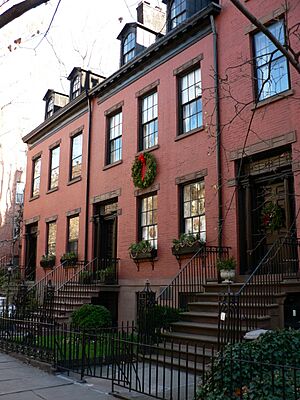
Brooklyn's neighborhoods are always changing. For example, Brownsville used to have mostly Jewish residents. Now, it's mostly African American. Midwood was once Irish, then Jewish, and is now becoming a Pakistani area.
Brooklyn attracts people from other U.S. cities like Chicago and San Francisco.
A Mix of Cultures: Community Diversity
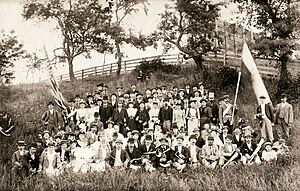
New York City is a place where people from all over the world come together. Brooklyn shows this with its many different cultures and backgrounds. In 2010, over half of Brooklyn's population belonged to religious groups. In 2014, Brooklyn had 914 religious organizations, one of the most in the country.
Brooklyn has many distinct neighborhoods, each with its own cultural feel. Here are some of the main groups:
Jewish American Communities
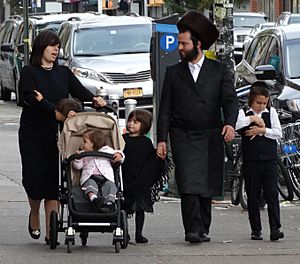
Over 600,000 Jews, especially Orthodox and Hasidic Jews, live in areas like Borough Park, Williamsburg, and Midwood. These neighborhoods have many Jewish schools (yeshivas), places of worship (synagogues), kosher restaurants, and Jewish businesses. Other Jewish neighborhoods include Canarsie and Crown Heights, home to the Chabad world headquarters.
Chinese American Communities
Over 200,000 Chinese Americans live in southern Brooklyn, mainly in Sunset Park, Bensonhurst, and Gravesend. Brooklyn has the most Chinatowns in New York City. The largest is in Sunset Park along 8th Avenue, known for its Chinese culture and many Chinese restaurants. They also have a popular Chinese New Year celebration.
Caribbean and African American Communities
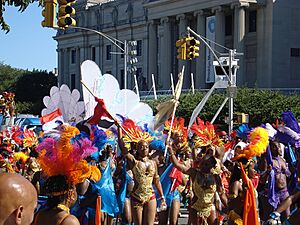
Brooklyn's African American and Caribbean communities are found throughout the borough. The West Indian community is strong in Crown Heights, Flatbush, and East Flatbush. Brooklyn has the largest West Indian community outside the Caribbean islands. Many West Indian restaurants and bakeries are in Crown Heights and Flatbush.
Brooklyn hosts a famous West Indian Day Parade every Labor Day on Eastern Parkway. The Brooklyn Academy of Music also has the DanceAfrica festival in May, celebrating African food and culture. Bedford-Stuyvesant has been a well-known African American community since 1936.
Hispanic American Communities
After World War II, many Puerto Rican migrants settled in waterfront neighborhoods like Sunset Park and Red Hook. Later, people from other Latin American countries also moved to Brooklyn.
Bushwick is now the biggest center for Brooklyn's Hispanic American community. It has many Puerto Ricans, Dominicans, and Mexicans. Bushwick's residents have created many businesses that support their different traditions. Sunset Park also has a large Hispanic population.
Russian and Ukrainian American Communities
Brooklyn is home to many Russians and Ukrainians, mostly in Brighton Beach and Sheepshead Bay. Brighton Beach has many Russian and Ukrainian businesses and is called Little Russia or Little Odessa. Many Soviet Jews moved here in the 1970s.
Polish American Communities
Brooklyn's Polish residents are mainly in Greenpoint, which is known as Little Poland. There are also Polish communities in Borough Park and Sunset Park.
Italian American Communities
Many Italian Americans live in neighborhoods like Bensonhurst, Dyker Heights, and Bay Ridge. These areas have many Italian restaurants, bakeries, and cafes.
Arab American & Muslim Communities
In the early 1900s, many Lebanese and Syrian Christians settled near Atlantic Avenue. More recently, Muslim Arab immigrants, especially Egyptians and Lebanese, have moved to Bay Ridge. This area has many Middle Eastern restaurants, Islamic shops, and mosques.
Brighton Beach has a growing Pakistani American community. Midwood is home to Little Pakistan along Coney Island Avenue. Pakistan Independence Day is celebrated there every year. Kensington is becoming a Bangladeshi neighborhood.
Irish American Communities
Many generations of Irish Americans live throughout Brooklyn. You can find them in neighborhoods like Windsor Terrace, Park Slope, and Bay Ridge. Many Irish Americans work in public services like law enforcement and the fire department.
South Asian American Communities
Nearly 30,000 Indian Americans live in Brooklyn. Brighton Beach has a growing Pakistani American community, and Midwood is home to Little Pakistan. Kensington is an emerging Bangladeshi neighborhood.
Greek American Communities
Brooklyn's Greek Americans live throughout the borough. There's a notable group in Bay Ridge with Greek schools, businesses, and cultural places. Greek-owned diners are common across Brooklyn.
LGBTQ Community
Brooklyn has a large and growing number of same-sex couples. Same-sex marriages became legal in New York in 2011. The Park Slope neighborhood became popular among lesbians, and Prospect Heights also has an LGBT community. Many neighborhoods are now home to LGBT communities.
Artists in Brooklyn
Brooklyn became a popular place for artists to live and work. This happened after it became too expensive to live in Manhattan. Neighborhoods like Williamsburg, DUMBO, and Red Hook became popular for artists. However, living costs have gone up in these areas, so some artists are moving to less expensive places.
Brooklyn's People: Demographics
| Historical population | ||
|---|---|---|
| Year | Pop. | ±% |
| 1731 | 2,150 | — |
| 1756 | 2,707 | +25.9% |
| 1771 | 3,623 | +33.8% |
| 1786 | 3,966 | +9.5% |
| 1790 | 4,549 | +14.7% |
| 1800 | 5,740 | +26.2% |
| 1810 | 8,303 | +44.7% |
| 1820 | 11,187 | +34.7% |
| 1830 | 20,535 | +83.6% |
| 1840 | 47,613 | +131.9% |
| 1850 | 138,822 | +191.6% |
| 1860 | 279,122 | +101.1% |
| 1870 | 419,921 | +50.4% |
| 1880 | 599,495 | +42.8% |
| 1890 | 838,547 | +39.9% |
| 1900 | 1,166,582 | +39.1% |
| 1910 | 1,634,351 | +40.1% |
| 1920 | 2,018,356 | +23.5% |
| 1930 | 2,560,401 | +26.9% |
| 1940 | 2,698,285 | +5.4% |
| 1950 | 2,738,175 | +1.5% |
| 1960 | 2,627,319 | −4.0% |
| 1970 | 2,602,012 | −1.0% |
| 1980 | 2,230,936 | −14.3% |
| 1990 | 2,300,664 | +3.1% |
| 2000 | 2,465,326 | +7.2% |
| 2010 | 2,504,700 | +1.6% |
| 2020 | 2,736,074 | +9.2% |
| 1731–1786 U.S. Decennial Census 1790–1960 1900–1990 1990–2000 2010 2020 Source: U.S. Decennial Census
|
||
|
New York City's five boroughs
|
||||||
|---|---|---|---|---|---|---|
| Jurisdiction | Population | Land area | Density | |||
| Borough | County | Estimate (2015) |
square miles |
square km |
persons / sq. mi |
persons / sq. km |
|
|
|
1,644,518 | 22.83 | 59.1 | 72,033 | 27,826 |
|
|
|
1,455,444 | 42 | 110 | 34,653 | 13,231 |
|
|
|
2,636,735 | 71 | 180 | 37,137 | 14,649 |
|
|
|
2,339,150 | 109 | 280 | 21,460 | 8,354 |
|
|
|
474,558 | 58.5 | 152 | 8,112 | 3,132 |
|
|
8,550,405 | 303.33 | 781.1 | 28,188 | 10,947 | |
|
|
19,795,791 | 47,214 | 122,284 | 416.4 | 159 | |
|
|
||||||
| Racial composition | 2020 | 2010 | 1990 | 1950 | 1900 |
|---|---|---|---|---|---|
| White | 37.6% | 42.8% | 46.9% | 92.2% | 98.3% |
| —Non-Hispanic | 35.4% | 35.7% | 40.1% | n/a | n/a |
| Black or African American | 26.7% | 34.3% | 37.9% | 7.6% | 1.6% |
| Hispanic or Latino (of any race) | 18.9% | 19.8% | 20.1% | n/a | n/a |
| Asian | 13.6% | 10.5% | 4.8% | 0.1% | 0.1% |
| Two or more races | 8.7% | 3.0% | n/a | n/a | n/a |
In 2020, 2,736,074 people lived in Brooklyn. This means Brooklyn's population grew by 2.2% between 2010 and 2019. Brooklyn makes up about 30.7% of New York City's total population.
In 2019, there were about 958,567 households in Brooklyn. Each household had an average of 2.66 people.
Different Backgrounds: Ethnic Groups
| Ancestry in Brooklyn Borough (2014–2018) | ||||
|---|---|---|---|---|
| Origin | percent | |||
| African American (Does not include West Indian or African) | 16.4% | |||
| West Indian American (Except Hispanic Groups) | 11.5% | |||
| East Asian American (Includes Chinese, Japanese, Vietnamese, etc.) | 8.4% | |||
| English American (*Includes "American" ancestry) | 7.6% | |||
| Puerto Rican American | 5.7% | |||
| Italian American | 4.8% | |||
| Russian and Eastern European (Includes Russian, Ukrainian, Soviet Union, etc.) | 4.3% | |||
| Central European (Includes Slovakian, Slovenian, Slavic, Czech, etc.) | 4.2% | |||
| Mexican American | 4.1% | |||
| Irish American | 3.8% | |||
| Dominican American | 3.5% | |||
| German American | 2.8% | |||
| South Asian American | 2.4% | |||
| South American (Includes Peruvian, Ecuadorian, Argentinian, etc.) | 2.3% | |||
| 2% | ||||
| Central American (Includes Honduran, Salvadoran, Costa Rican, etc.) | 1.9% | |||
| Other | 14.7% | |||
In 2020, Brooklyn's population was about 35.4% non-Hispanic white, 26.7% Black or African American, and 13.6% Asian. People of Hispanic or Latin American background made up 18.9% of the population.
Speaking Different Tongues: Languages
Brooklyn has many different languages spoken. In 2010, about 54.1% of residents aged 5 and older spoke English at home. Other common languages include Spanish (17.2%), Chinese (6.5%), Russian (5.3%), and Yiddish (3.5%). In total, 45.9% of Brooklyn's population spoke a language other than English at home.
Brooklyn's Vibe: Culture
Brooklyn has had a big impact on American culture, especially in books, movies, and theater. The "Brooklyn accent" was once famous as the typical New Yorker accent. Brooklyn's official colors are blue and gold.
Places for Culture: Cultural Venues
Brooklyn is home to the famous Brooklyn Academy of Music (BAM) and the Brooklyn Philharmonic orchestra. It also has the second-largest public art collection in the U.S. at the Brooklyn Museum.
The Brooklyn Museum, opened in 1897, is New York City's second-largest public art museum. It has over 1.5 million objects, from ancient Egyptian art to modern pieces. The Brooklyn Children's Museum, opened in 1899, was the world's first museum just for kids.
BAM has a large opera house and theater. Bargemusic and St. Ann's Warehouse are also popular arts spots in the DUMBO area.
News and Media in Brooklyn
Local Newspapers and Magazines
Brooklyn has several local newspapers like The Brooklyn Daily Eagle and The Brooklyn Paper. It's also covered by major New York City newspapers like The New York Times.
Magazines like Brooklyn Magazine focus on life and culture in Brooklyn.
Newspapers in Other Languages
Brooklyn has many newspapers published in different languages. El Diario La Prensa, the oldest Spanish-language newspaper in the U.S., has its main office in Downtown Brooklyn. Other papers include The Tablet (Catholic), Hamodia (Orthodox Jewish), and The Jewish Press (Orthodox Jewish). Over 60 ethnic groups publish about 300 non-English magazines and newspapers in New York City.
Television in Brooklyn
New York City has its own official TV station, NYC Media, which shows programs about Brooklyn. Brooklyn Community Access Television (BCAT) is Brooklyn's public access channel.
Fun Events in Brooklyn
- The annual Coney Island Mermaid Parade (in June) is a colorful parade with costumes and floats.
- Coney Island also hosts the yearly Nathan's Hot Dog Eating Contest on July 4th.
- The annual Labor Day Carnival (also called the West Indian Day Parade) takes place on Eastern Parkway in Crown Heights.
- The Art of Brooklyn Film Festival happens every June.
Brooklyn's Work: Economy
Brooklyn's job market depends on the national economy, New York City's economy, and people moving into the borough. About 44% of Brooklyn's working population, or 410,000 people, work within Brooklyn. More than half of Brooklyn residents work outside the borough.
Since the late 1900s, Brooklyn has seen growth in financial services and high-tech companies. Jobs have shifted from manufacturing to service industries. In 2004, 215,000 Brooklyn residents worked in services, while 27,500 worked in manufacturing.
The Brooklyn Navy Yard was once the largest employer in the borough. It built famous ships like the Missouri and the Monitor. Today, it's home to design firms, food businesses, and film production companies.
Most businesses in Brooklyn are small. In 2000, 91% of Brooklyn's businesses had fewer than 20 employees. Construction and services are the fastest-growing job areas.
Brooklyn is also attracting many high technology startup companies.
Fun Places: Parks and Attractions

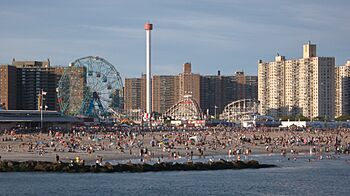
- Brooklyn Botanic Garden: This 52-acre garden has a cherry tree path, a rose garden, a Japanese garden, and many other beautiful plant collections.
- Coney Island: This famous amusement area developed in the early 1900s. The Cyclone rollercoaster, built in 1927, is a historic landmark. The Wonder Wheel from 1920 and other rides are still working. Coney Island has seen a comeback in recent years.
- Floyd Bennett Field: This was New York City's first airport. Now it's part of the National Park System. You can find nature trails and different habitats here.
- Green-Wood Cemetery: Founded in 1838, this is a beautiful, historic cemetery where many famous New Yorkers are buried.
- Jamaica Bay Wildlife Refuge: This is a unique wildlife refuge on the border of Brooklyn and Queens.
- New York Transit Museum: This museum shows old subway cars, buses, and other items from New York's public transport history. It's located in an old subway station.
- Prospect Park: This large public park in central Brooklyn covers 585 acres. It was designed by the same people who created Central Park in Manhattan. It has a huge meadow, a zoo, a lake, and a bandshell for concerts. Prospect Park also hosts a popular Halloween Parade.
- Fort Greene Park: This park in the Fort Greene neighborhood has the Prison Ship Martyrs' Monument. This monument honors American prisoners from the Revolutionary War.
Sports in Brooklyn
Brooklyn's main professional sports team is the NBA's Brooklyn Nets. They moved to Brooklyn in 2012 and play at Barclays Center. The New York Liberty of the WNBA also play at Barclays Center.
Brooklyn has a rich sports history. Many famous athletes like Mike Tyson and Sandy Koufax came from Brooklyn. Basketball legend Michael Jordan was born in Brooklyn.
In the early days of baseball, Brooklyn teams were very strong. The second recorded baseball game was played near Fort Greene Park in 1845. Brooklyn teams helped baseball become the modern game we know today.
Brooklyn's most famous team was the Brooklyn Dodgers baseball team. They were named after "trolley dodgers." In 1947, Jackie Robinson joined the Dodgers, becoming the first African-American player in Major League Baseball in the modern era. In 1955, the Dodgers won their only World Series for Brooklyn. Two years later, the Dodgers moved to Los Angeles.
Professional baseball returned to Brooklyn in 2001 with the Brooklyn Cyclones. They are a minor league team that plays in MCU Park in Coney Island.
Where People Live: Housing
Brooklyn has many types of homes, including private houses and apartments. Public housing is managed by the New York City Housing Authority (NYCHA). In 2022, there were over 1.1 million housing units in Brooklyn. NYCHA provides homes for over 100,000 residents.
Learning in Brooklyn: Education
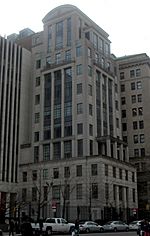
Brooklyn has many public and private schools. Public schools are run by the New York City Department of Education, the largest public school system in the U.S.
Brooklyn Technical High School (Brooklyn Tech) is a large public high school for science, math, and technology. It opened in 1922 and is known for its famous graduates and strong academics.
Colleges and Universities: Higher Education
Public Colleges
Brooklyn College is a public college that was the first coeducational (for both boys and girls) liberal arts college in New York City. Many of its students are first or second-generation Americans. Medgar Evers College, founded in 1970, is another public college that offers various programs.
New York City College of Technology (City Tech) is the largest public technology college in New York State. It started in 1881 as the Technical Schools of the Metropolitan Museum of Art.
SUNY Downstate College of Medicine, founded in 1860, is the oldest hospital-based medical school in the U.S.
Private Colleges
Adelphi University and St. Francis College have campuses in Downtown Brooklyn. Brooklyn Law School, founded in 1901, is known for its diverse students.
Long Island University has a campus in Downtown Brooklyn with strong science and medical technology programs. Pratt Institute, in Clinton Hill, is a private college for engineering, architecture, and arts.
The New York University Tandon School of Engineering is the second oldest private technology institute in the U.S. It's part of New York University (NYU) and has its main campus in Downtown's MetroTech Center.
St. Francis College is a Catholic college founded in 1859. It's a small liberal arts college with over 2,400 students.
Community Colleges
Kingsborough Community College is a junior college in the City University of New York system, located in Manhattan Beach.
Brooklyn Public Library
The Brooklyn Public Library is a separate system from New York and Queens libraries. It offers thousands of programs, millions of books, and free internet access. It has books in many languages spoken in Brooklyn, like English, Russian, Chinese, and Spanish. The Central Library is a famous building facing Grand Army Plaza.
There are 58 library branches in Brooklyn, so one is close to every resident.
Getting Around: Transportation
About 57% of households in Brooklyn do not own a car.
Public Transportation
Brooklyn has a large public transportation system. Nineteen New York City Subway lines run through the borough. About 92.8% of Brooklyn residents who travel to Manhattan use the subway. Major subway stations include Atlantic Avenue–Barclays Center and Jay Street–MetroTech.
Brooklyn also has a large public bus network that covers the entire borough. There is also express bus service to Manhattan. New York's yellow cabs also operate in Brooklyn.
There are three commuter train stations in Brooklyn: East New York, Nostrand Avenue, and Atlantic Terminal. Atlantic Terminal is a major hub with many subway connections.
In 2015, New York City started a citywide ferry service called NYC Ferry. It opened in 2017, with routes serving different parts of Brooklyn and connecting to Manhattan.
Roads and Bridges
Most of Brooklyn's main highways are in the western and southern parts. These include Interstate 278 (the Gowanus Expressway and Brooklyn–Queens Expressway) and the Brooklyn–Battery Tunnel. Other important roads are the Belt Parkway and the Jackie Robinson Parkway.
Many parts of Brooklyn have named streets. But areas like Park Slope, Bay Ridge, and Bensonhurst have numbered streets running one way and numbered avenues running another.
Brooklyn is connected to Manhattan by three bridges: the Brooklyn Bridge, Manhattan Bridge, and Williamsburg Bridge. It's also connected by a tunnel, the Brooklyn–Battery Tunnel, and several subway tunnels. The Verrazzano-Narrows Bridge connects Brooklyn to Staten Island. Brooklyn also shares several bridges with Queens over Newtown Creek.
Waterways and Ports
Brooklyn used to be a major shipping port. Most large cargo ship operations have moved to New Jersey. However, the Brooklyn Cruise Terminal in Red Hook is a busy spot for cruise ships. The Queen Mary 2, one of the world's largest ocean liners, was designed to fit under the Verrazzano-Narrows Bridge and often stops in Red Hook.
In 2015, the city started the NYC Ferry service to connect Brooklyn's waterfront to Manhattan.
Brooklyn's Global Friends: Partnerships with Other Cities
Brooklyn has partnerships with districts in cities around the world. These include:
- Anzio, Lazio, Italy (since 1990)
- Huế, Vietnam
- Gdynia, Poland (since 1991)
- Beşiktaş, Istanbul Province, Turkey (since 2005)
- Leopoldstadt, Vienna, Austria (since 2007)
- London Borough of Lambeth, United Kingdom
- Bnei Brak, Israel
- Konak, İzmir, Turkey (since 2010)
- Chaoyang District, Beijing, China (since 2014)
- Yiwu, China (since 2014)
- Üsküdar, Istanbul, Turkey (since 2015)
Staying Healthy: Hospitals and Healthcare
Brooklyn has many hospitals and healthcare centers, including:
- Brookdale University Hospital and Medical Center
- Kings County Hospital Center
- Maimonides Medical Center
- Mount Sinai Brooklyn
- New York Community Hospital
- NYC Health + Hospitals/Kings County
- NYU Langone Hospital – Brooklyn
- SUNY Downstate Medical Center
See also
 In Spanish: Brooklyn para niños
In Spanish: Brooklyn para niños


